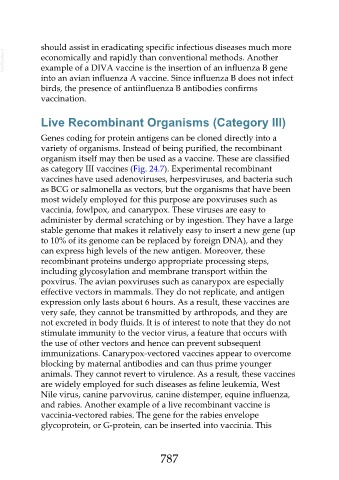Page 787 - Veterinary Immunology, 10th Edition
P. 787
should assist in eradicating specific infectious diseases much more
VetBooks.ir economically and rapidly than conventional methods. Another
example of a DIVA vaccine is the insertion of an influenza B gene
into an avian influenza A vaccine. Since influenza B does not infect
birds, the presence of antiinfluenza B antibodies confirms
vaccination.
Live Recombinant Organisms (Category III)
Genes coding for protein antigens can be cloned directly into a
variety of organisms. Instead of being purified, the recombinant
organism itself may then be used as a vaccine. These are classified
as category III vaccines (Fig. 24.7). Experimental recombinant
vaccines have used adenoviruses, herpesviruses, and bacteria such
as BCG or salmonella as vectors, but the organisms that have been
most widely employed for this purpose are poxviruses such as
vaccinia, fowlpox, and canarypox. These viruses are easy to
administer by dermal scratching or by ingestion. They have a large
stable genome that makes it relatively easy to insert a new gene (up
to 10% of its genome can be replaced by foreign DNA), and they
can express high levels of the new antigen. Moreover, these
recombinant proteins undergo appropriate processing steps,
including glycosylation and membrane transport within the
poxvirus. The avian poxviruses such as canarypox are especially
effective vectors in mammals. They do not replicate, and antigen
expression only lasts about 6 hours. As a result, these vaccines are
very safe, they cannot be transmitted by arthropods, and they are
not excreted in body fluids. It is of interest to note that they do not
stimulate immunity to the vector virus, a feature that occurs with
the use of other vectors and hence can prevent subsequent
immunizations. Canarypox-vectored vaccines appear to overcome
blocking by maternal antibodies and can thus prime younger
animals. They cannot revert to virulence. As a result, these vaccines
are widely employed for such diseases as feline leukemia, West
Nile virus, canine parvovirus, canine distemper, equine influenza,
and rabies. Another example of a live recombinant vaccine is
vaccinia-vectored rabies. The gene for the rabies envelope
glycoprotein, or G-protein, can be inserted into vaccinia. This
787

